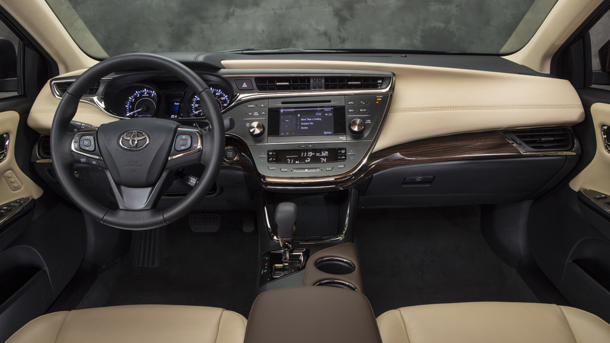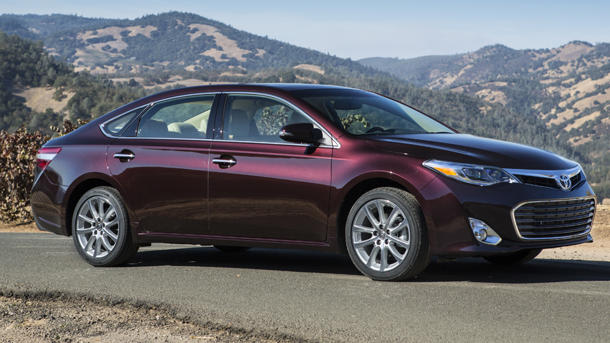2013 Toyota Avalon gets its hip replacement: Motoramic Drives
By Neal Pollack | Motoramic – 16 hours ago
Even by the standards of America's rapidly aging
automotive customers, the Toyota Avalon is an old-man car. Anyone who's
ever been stupefied in traffic behind a shrunken Avalon driver going 30
mph in a 50 zone can testify to that truth, and it's been thus since
Toyota launched the Avalon in 1995, replacing the much-unloved Cressida.
Toyota created the Avalon to get drivers to the early bird special and
back home in time for Matlock. In the company's words, it was
"designed for long-term members of the Toyota family who were getting
older and wanted more comfort." Well, Matlock is dead now, and so are
most of the Avalon's original customers. It's time for a reboot.
Toyota says the current median age of Avalon buyers is 64, which puts
it in the neighborhood of Polident, just south of adult diapers. Try to
find a vehicle other than a Hoveround scooter with an older
demographic. With the 2013 Avalon, representing the brand's 4th
generation, Toyota is gunning for a "broader audience of Gen-X and
trail boomers," the same small army of mythical yuppies that every other
entry-level luxury car chases. Their new buyer age goal is, like a
crisp fall day, somewhere in low 50s. As we prepared to drive the new
Avalon last week in Napa Valley, the company said this more than once,
using words not usually associated with the Avalon, including "sleek,"
"sporty," "dramatic," "exotic," and "driver-connected." If that's how
they're presenting the new Avalon, then that's how the new Avalon shall
be judged.Let's start with design. The old Avalons resemble orthopedic shoes: Square, sensible, and dull. The 2013 marks a significant improvement; it's been completely made over to match current (positive) trends of automotive design, which sees previously boxy sedan models growing longer and slimmer, with more eccentric angles. In past Avalons, the grille sat flatly between the headlights, making it look like the car was wearing reading glasses. The new model -- designed entirely in the United States for the first time -- features a two-level grille, with the larger, thicker one dropped below wheel level, allowing for a longer, sloping hood and less bulgy headlights. In the rear, the car appears more tapered and less metallic. The trunk integrates nicely into the car's main body, not sticking out, as in previous models, like an oversized booty in mall sweatpants. If the car has a major design flaw, it's that the 17-inch wheels seem a bit small, more suited to a compact car than a full-sized sedan.
 Despite
a few tacky-feeling faux-wood accents, the inside is even more
impressive, with a sharp, soft-touch dashboard, full of angular lines
that actually grow more interesting to look at as you spend time in the
car. It has the requisite shipboard computer in the center console, but
it's not overwhelmingly techy -- there are analog options in case
grandma can't figure out how to program the DVR. The seats are
comfortable enough, though strangely lacking in lumbar support, and
there's lots of legroom in the front and the rear. It feels restful and
moderately upscale, like the waiting room of a high-end doctor's office.
All it's missing is a rubber plant, a water cooler, and side-pocket
copies of MORE and Sports Illustrated. As one Toyota
employee refreshingly said to us as we prepared to drive, "this would be
a car that might appeal to your more upwardly-mobile buyer who's deep
into the Viagra."
Despite
a few tacky-feeling faux-wood accents, the inside is even more
impressive, with a sharp, soft-touch dashboard, full of angular lines
that actually grow more interesting to look at as you spend time in the
car. It has the requisite shipboard computer in the center console, but
it's not overwhelmingly techy -- there are analog options in case
grandma can't figure out how to program the DVR. The seats are
comfortable enough, though strangely lacking in lumbar support, and
there's lots of legroom in the front and the rear. It feels restful and
moderately upscale, like the waiting room of a high-end doctor's office.
All it's missing is a rubber plant, a water cooler, and side-pocket
copies of MORE and Sports Illustrated. As one Toyota
employee refreshingly said to us as we prepared to drive, "this would be
a car that might appeal to your more upwardly-mobile buyer who's deep
into the Viagra."
Previous Avalons drove softer than feather
pillows and about as agile as a tuna casserole. Toyota has tightened the
2013 up by about 30 percent. The new Avalon isn't exactly going to melt
your face, but it's good enough. It still veers away from fun and more
towards comfortable, but at least it doesn't feel like you're drifting
on an oversized marshmallow. The standard V6 engine, which includes a
six-speed transmission, gets up to 268 hp. It's got decent pickup and
steering that's at least average, if not better. Higher-end trim models
feature a paddle shifter and a Sport mode, though for a car like this,
"Dynamic Rev Management" feels a bit superfluous. Also, with a 21/31 mpg
fuel economy rating, the Avalon doesn't exactly get to stand first in
line for fuel-economy awards.
That award is reserved for the hybrid edition of the car, which gets a
classy 40 mpg, the same as the hybrids of the Camry and the Lexus
ES350, with which it shares a drive train. But despite sharing all the
design improvements of the V6, the Avalon hybrid, as so often happens,
has to sacrifice a bit of performance, getting only 156 hp. That goes up
to 200 hp if you can figure out how to drive it optimally using the
battery pack. You'd have to have a pretty broad definition of fun to say
that it's fun to drive.As for the brakes on the hybrid, let's charitably call them "challenging." The Avalon seemed to slow down easily, but then it would stop with a sudden, jarring jerk, which didn't seem normal. My drive partner, who's far smarter than I, explained this as the hybrid-specific problem of an "abrupt transition between regenerative and friction braking." It wasn't ideal. The brakes on the V6 model didn't have the same problem, and worked efficiently.
Pricing will range, depending on trim level, from just under $31,000 to $39,500 for the conventional engine and between $35,555 to $41,400 for the hybrid. That's not going to help Toyota's ambition of shooting for a younger demographic, which seeks value most of all in car purchases, even luxury ones. This new Avalon is clearly a better car than before, in almost every way. The company has successfully updated the Avalon from Matlock to The Good Wife. But as a card-carrying member of Gen X, I'm hard-pressed to see it appealing to us.
Maybe when we're 64.

No comments:
Post a Comment